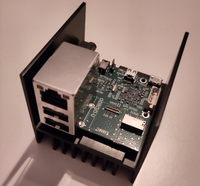ODROID U2 (odroid-u2)
Appearance
 ODROID U2 | |
| Manufacturer | ODROID |
|---|---|
| Name | U2 |
| Codename | odroid-u2 |
| Released | 2012 |
| Type | single board computer |
| Hardware | |
| Chipset | Samsung Exynos 4412 Quad |
| CPU | Quad-core 1.7 GHz A9 |
| GPU | Mali 400 MP4 |
| Display | None |
| Storage | eMMC card or microSD |
| Memory | 2GB LPDDR3 |
| Architecture | armv7 |
| Software | |
Original software The software and version the device was shipped with. |
Ubuntu 14.04 LTS |
Extended version The most recent supported version from the manufacturer. |
Ubuntu |
| postmarketOS | |
| Category | testing |
Mainline Instead of a Linux kernel fork, it is possible to run (Close to) Mainline. |
yes |
| Device package |
|
| Kernel package |
|
Flashing Whether it is possible to flash the device with pmbootstrap flasher. |
Untested
|
|---|---|
USB Networking After connecting the device with USB to your PC, you can connect to it via telnet (initramfs) or SSH (booted system). |
Works
|
Battery Whether charging and battery level reporting work. |
Untested
|
Screen Whether the display works; ideally with sleep mode and brightness control. |
Untested
|
Touchscreen |
Untested
|
| Multimedia | |
3D Acceleration |
Works
|
Audio Audio playback, microphone, headset and buttons. |
Untested
|
Camera |
Untested
|
| Connectivity | |
WiFi |
Untested
|
Bluetooth |
Untested
|
GPS |
Untested
|
NFC Near Field Communication |
Untested
|
| Modem | |
Calls |
Untested
|
SMS |
Untested
|
Mobile data |
Untested
|
| Miscellaneous | |
FDE Full disk encryption and unlocking with unl0kr. |
Untested
|
USB OTG USB On-The-Go or USB-C Role switching. |
Untested
|
| Sensors | |
Accelerometer Handles automatic screen rotation in many interfaces. |
Untested
|
Contributors
Users owning this device
Installation
| This device package is compatible with odroid-u3 as well |
1. Use pmbootstrap to create a bootable SD card:
pmbootstrap init # pick 'odroid' as manufacturer, 'u2' as device. pmbootstrap install --sdcard=/dev/sdX
You can choose between using Alpine Linux's ![]() linux-lts kernel, or PostmarketOS's
linux-lts kernel, or PostmarketOS's ![]() linux-postmarketos-exynos4 kernel. Both work rather well.
linux-postmarketos-exynos4 kernel. Both work rather well.
You must install the nonfree firmware package for this device to get it booting. It contains early bootloaders which initialise the hardware and then boot u-boot.
2. Insert SD card or eMMC card into the Odroid U2, plug in the Ethernet cable and turn it on.
3. The Odroid U2 should boot up, get an ip address, and become accessible over SSH.
| If the Odroid does not appear on your local network, its Ethernet may be disabled. One can enable it by attaching a keyboard and following the Alpine wiki: sudo setup-interfaces && sudo /etc/init.d/networking --quiet restart && sudo rc-update add networking boot. Ethernet also will not work if the system time is too out of date. It should sync automatically, but if that process is too slow you might want to manually edit the date and time. |